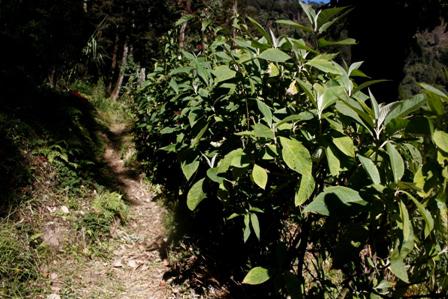Roshan Patrick Rai
Other projects
1 Dec 2010
Community-Based Mitigation of Human-Wildlife Conflict Around the Singalila National Park, India I
18 Apr 2016
Community-Based Mitigation of Human-Wildlife Conflict around the Singalila National Park, India III
There are two aims for this project:
i. Advocate for the recognition of Human Wildlife Conflict in Singalila National Park in the conservation discourse and
ii. Initiate community-based initiatives to reduce impacts of human wildlife conflict.

Bich-Gaon forest village bio-fence, Nov 2013.
Human wildlife conflict (HWC), a key stake for communities in the fringes of Singalila National Park(SNP), India, will be further documented in five forest villages for advocacy, as there is a large data gap(the West Bengal Fact Finding Commission on Environment, non-judicial, 12 October 2012, accepted the case of Samanden Forest Village(FV)on HWC but requested more data). HWC policy in India as of now does not include mountain regions. In the pilot phase, a daily HWC data was generated over a period of April 2011 to May 2012 from Samanden FV which showed 13 different species (none in the list of problem animals) raiding crops and livestock. This cost of conservation is being borne by forest village communities who are already living in difficult circumstances.

Dara Gaon- bio-fence, Nov 2013.
Bio-fence and alternate crops not damaged by wildlife, an outcome of the lessons learnt of the pilot project, will be promoted in 5 forest fringe communities of SNP through progressive villagers, as a mitigation and adaptive measure. Progressive villagers will enable the community to learn and adapt by seeing and doing and reduces the risk of rejection. Selection of species will take into consideration increasing agro-biodiversity and stepping stones in a fragmented forest landscape as well as additional livelihoods option. The project will be done in collaboration with Darjeeling Singalila Sangrachan Samity(Conservation Association) a network of forest villagers and the Forest Department. The linkages created with WWF Kangchenjunga Landscape Programme will be strengthened and expanded to include other like-minded organisations to build a critical mass advocating for HWC in the mountain regions. Addressing HWC will increase community participation and stewardship in conservation. It will ultimately reduce forest fragmentation and increase connectivity in the critical tranboundary ‘Kangchenjunga Singhalila Complex’.